| 1 | Elegant snail eater |
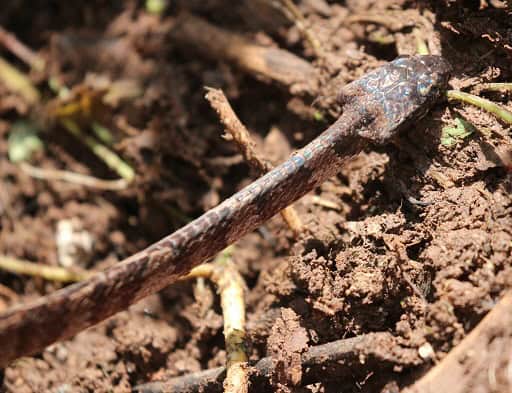
Three days ago we wrote about 10 snakes which aren’t cobras, yet have the same ability to flare a wide neck hood. Today, we have something similar but different – snakes that can deliberately triangulate their head in order to mimic vipers. Virtually all vipers worldwide, from rattlesnakes to European adders, have sharply triangular heads, and by copying this, several non-venomous snakes hope to gain a safety shield, through the shady arts of deception.
First up is the elegant snail eater, which measures up to 93.3cm and is found exclusively in Ecuador. Dipsas elegans lives only on the western slopes of the Andes, yet where they exist, they’re very common, including near the capital Quito. They’re non-venomous, and normally found on branches and low bushes 0.5-4 metres high. With no power to harm humans, monkeys or birds, they’ve chosen a different strategy – sharply triangulating their head by shifting bones sideways, activated by stress responses.
The image above speaks for itself. See this image for the shape of their head when not stressed. It’s slightly bulky, not a continuous tube like a coral snake’s head, but it pales next to the triangular shape they’re capable of producing at will. The most likely species Dipsas elegans is mimicking is the Ecuadorian toad-headed pitviper (Bothrocophias campbelli), which has similar brown shades and is equally common in the hills near Quito.
| 2 | Red-lipped snake |
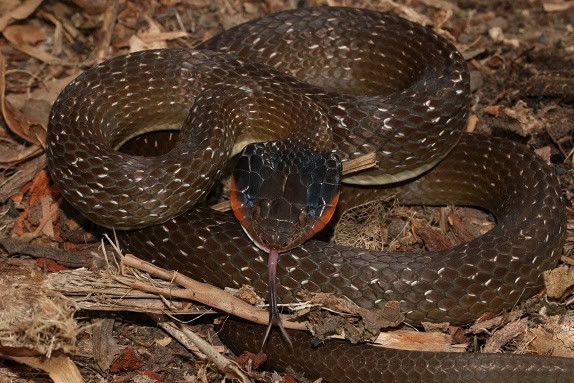
Though they fail for venom and agility, the red-lipped snake might be the king of South African serpents for head triangulation, alongside common egg-eaters. This 70cm species is found in moist gardens and grassland rather than arid rocky plains, preferring anywhere amphibians congregate. Red-lipped snakes (Crotaphopeltis hotamboeia) are also known as herald snakes, and prey on species such as common African toads, Mascarene grass frogs and common agamas.
Herald snakes are a variable species, ranging from brown to grey to greenish. But all morphs share the ability to rearrange their skull at will, making it sharply triangular, with the goal of mimicking a dangerously venomous viper. They combine this with a sharp S-shaped coil and repeated mock lunges at the enemy, completing the mimic.
Herald snakes have a venom of their own, but this causes only a slight swelling. Because their colours vary, it’s difficult to establish which viper they’re masquerading as. South Africa is home to puff adders (beige), red adders, and common night adders (grey). Its possible that local birds such as brown snake eagles are so accustomed to vipers that any triangular head sends their alarm signals ringing, without requiring a corresponding colour. Crotaphopeltis hotamboeia also falls victim to many fellow snakes, such as purple glossed snakes and shield-nosed snakes.
| 3 | Viperine water snake |
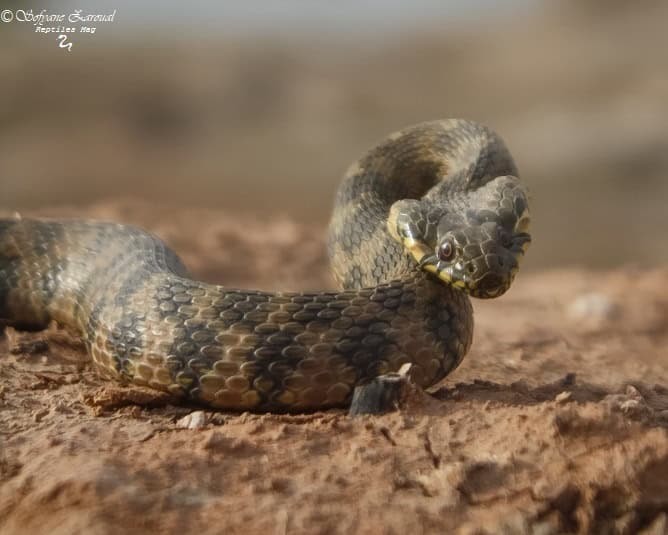
The cousin of the grass snake. Natrix maura is a slightly venomous species which inhabits watery zones of Spain, Portugal and far northern Africa. Their common name is viperine watersnake, and that’s because they combine every viper feature in the book without actually being one: wild warning lunges, S-shaped coils, beige-black patterns, and a sharply triangular head which they can enact at will.
In Europe, Natrix maura has walked further down the path of deceptive head triangulation than any other snake. In normal times, they have a slightly thicker head than their neck, which becomes almost a perfect triangle when cornered. Whether this is consciously triggered, or automatically activated by rising stress hormones, we cannot say.
Natrix maura preys mainly on fish and amphibians, and peaks at 92.9cm. The one ID sign to watch for is round pupils, rather than savagely vertical like virtually all vipers. As a common, regularly sighted species in Spain, birds can’t resist swooping down on this snake, whether it’s red kites, common buzzards, black-crowned night herons, grey herons or Egyptian vultures.
Their grass snake (Natrix helvetica) cousins are also capable of triangulating their head, though they do so less commonly. In fact, grass snakes can flare a cobra-like neck hood too, making them a rare species to combine both.
| 4 | South American hognose snake |
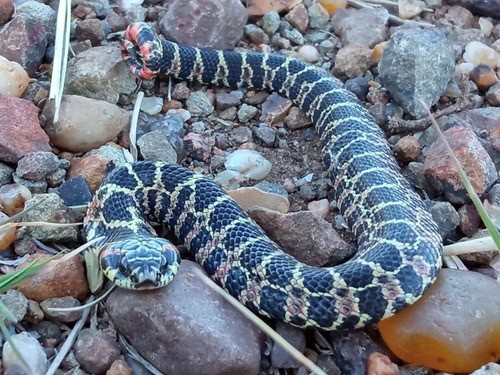
This thick Argentinian and Uruguayan snake has a bright red tail which it wiggles around to distract from its head. But it doesn’t stop there, as in case greedy predators don’t notice the tail, they can change their skull’s shape at will to make it more triangular.
Xenodon dorbignyi measure up to 65cm, and are found in spacious forests and grasslands, both with sandy soils that are easy to burrow in. A 2009 study found that this species has 9 defensive strategies in total, also including erratic body jerking and rapid flight. The study examined 31 individuals and found that 16.1% triangulated their head, 14.0% displayed their tail, and 18.8% flattened their entire body. Apparently, Xenodon dorbignyi was able to evaluate the exact level of threat posed by a predator.
The south Brazil/Argentine neighbourhood is chock full of venomous pitvipers like the crossed pitviper and painted lancehead (Argentina’s deadliest). Every animal nearby knows that thin, tube-like snakes are far easier to hunt than bulky ones with triangular heads. Some snakes are stuck with thin heads and can’t change, no matter how much they concentrate, but not Xenodon dorbignyi. This snake has been honoured with a prodigious power. The patterns are also a close mimic of Bothrops lanceheads, except the bright red tail.
| 5 | Uribe’s cat-eyed snake |
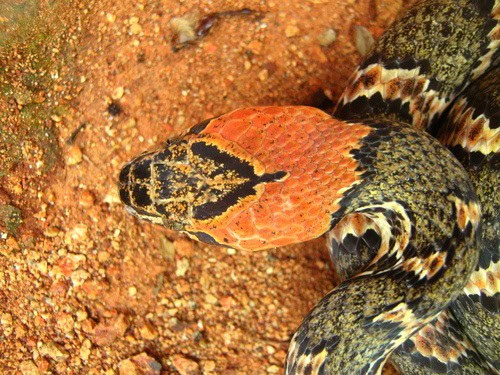
Several members of the Leptodeira cat-eyed snake family can change their skull shape to appear more triangular. This includes the extremely common annulated cat-eyed snake (L. annulata) of Brazil, and the southern Mexican Uribe’s cat-eyed snake (Leptodeira uribei). This species has mesmerising patterns, with a grey to slightly green body contrasting against a striking orange head, with a triangular section missing, so that the orange resembles Pacman about to eat something.
Uribe’s cat-eyed snakes have immensely complicated facial patterns as well, with subtle orange speckles. They mainly inhabit tropical deciduous forests, where they feed on frogs, and effortlessly climb trees by identifying weaknesses in bark.
Though no studies exist, there are many images of Leptodeira uribei triangulating its head. Their patterns are also vagely viperid, with large blotches of grey and brown. There’s no obvious candidate for which viper they’re mimicking. Mexico is overrun with rattlesnakes, yet none have such a bright head, or spend their days in days. Head triangulation seems to work as a generic defense.
| 6 | European catsnake |
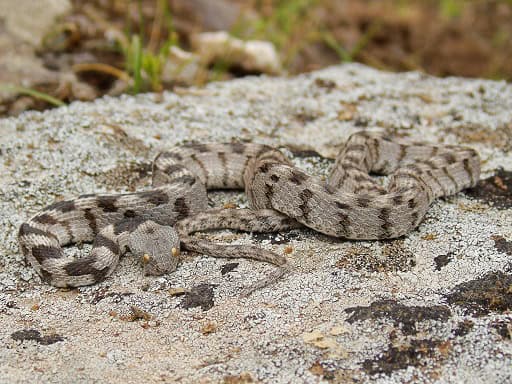
This southeast European snake is mainly found in dry, rocky areas, such as rock walls bordering agricultural fields and canyons. They have a slight venom, but hardly ever bite, and reach a maximum of 1.3 metres.
European catsnakes have the power to make their head triangular, when it’s normally only slightly bulky. But this species also takes it to the next level by tilting their head forwards, so that the enlarged surface faces the enemy.
European catsnakes have a large range from Slovenia through Greece and Turkey. In Israel, they look somewhat similar to Palestinian vipers, though fairly easy to distinguish. But their closest lookalike is the nose-horned viper (Vipera ammodytes) of Greece, the country’s most dangerous snake. Vipera ammodytes is a common snake, so it’s possible that the copycat triangular head (and colours) evolved here, before the European catsnake spread southwards to Israel, where the mimic wasn’t quite as precise, but still enough to spook skittish birds into flying far over the horizon.
In Greece, the main difference to nose-horned vipers is that most of the black blotches are disconnected, while they form continuous zigzags in the latter. However, both species have vertical pupils (unlike Natrix maura’s round pupils in Spain).
| 7 | Tropical snail-eater |
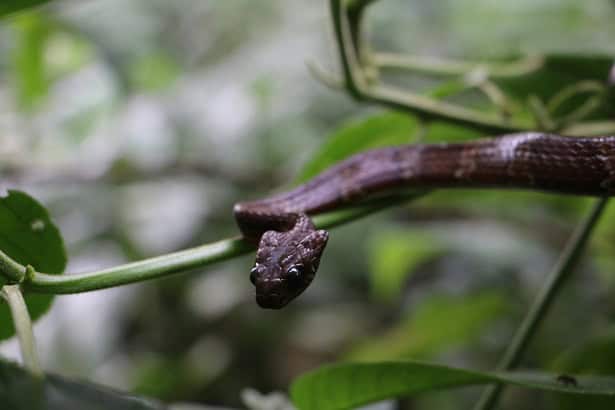
The masters of snake triangulation in the snake world are not who you’d expect. It’s a family which is otherwise non-threatening and unremarkable, the 30 member Dipsas family, all found in Central and South America and most of which people stroll past without paying the slightest attention to.
Tropical snail-eaters (Dipsas sanctijoannis) are Colombia’s most common snail eater, with an explosion of sightings in the centre around Bogota, although they suddenly disappear outside of Colombia. Like the elegant snail eater of Ecuador, they effortlessly triangulate their head, and do so regularly, as though delighted to use their power. In November 2008, for example, scientists encountered a tropical snail-eater on a shrub 1.8 metres high at 09:00. It began its escape by crawling slowly along the shrub’s branch, maintaining some stealth. But when picked up, it triangulated its skull, assumed an attack posture, and began swaying back and forth menacingly.
Dipsas sanctijoannis can also change its head shape without being touched, as seen above. Like all Dipsas members, this species has no venom and cannot kill a human. They’re only found in Colombia at altitudes of 1585-2400 metres.
| 8 | Smooth snake |
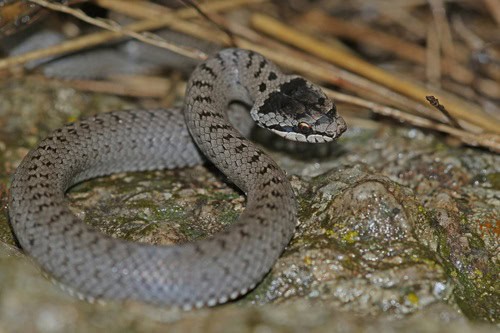
A non-venomous snake which rarely bites people even if gripped. The smooth snake (Coronella austriaca) averages at 60cm and prefers areas of tangled vegetation, which they can weave through and watch keenly for lizards scampering past, before following their trail and gaining inch by inch.
Smooth snakes pose no threat to larger predators, and have no ability to resist them. So they resort to stealthier methods instead, one of which is triangulating their head to mimic a lethal viper. Like European catsnakes and Natrix maura, smooth snakes achieve this by displacing their maxillary bone, the main bone of their upper jaw.
Smooth snakes don’t bare an exact resemblance to any local viper. The common adder has a thick black zigzag marking down its spine, while asp vipers have far blotchier patterns. But it’s a case of “close enough” with the smooth snake. Only a herpetological expert wouldn’t back off slowly with his heartbeat rapidly accelerating. Smooth snakes cover an enormous area, from southern England to western Kazakhstan, so instead of mimicking one species closely, they go for a one size fits all approach, where they can decently mimic most vipers of temperate climates.
| 9 | Common egg-eater |
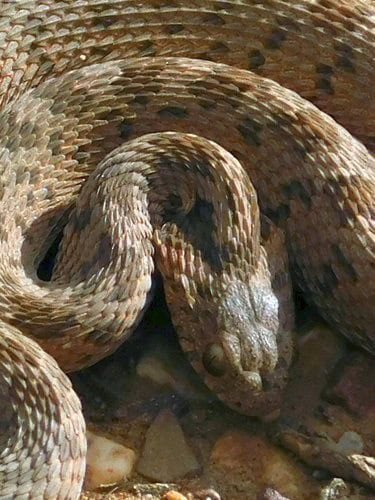
Alongside the herald snakes, Dasypeltis egg-eaters are the African family with the strongest speciality of head triangulation. This has been observed most in the common egg eater (Dasypeltis scabra), which is perhaps the most common member. This species ranges from South Africa and Zimbabwe, to Kenya and even Eritrea. It measures 60-70cm and swallows eggs whole, and while its head is always slightly bulky, it can enlarge it further to the sides during crises, to achieve a triangular shape.
There’s a great reason they’ve evolved this: Dasypeltis egg eaters barely even have teeth. Their diet only includes eggs, and these are cracked open using a modified spinal column. Instead, they must use tactics like acting unhinged by showing off a pitch black mouth lining, and pretending to be a puff adder or night adder and hoping that nobody sees through their deception.
Watching an egg slide down their throat is truly bizarre (see this image). Common egg eaters also have viper-esque patterns, with a mixture of subtle beige and brown. There’s several morphs, with some Daspyeltis scabra being a pure brick red, so the ones with viper patterns may have a double survival advantage. Or it’s possible that the red ones triangulate their head more than usual to compensate. This species usually lives in woodlands and lush savannahs, always with plenty of thickets to hide in.
| 10 | Diadem snake |
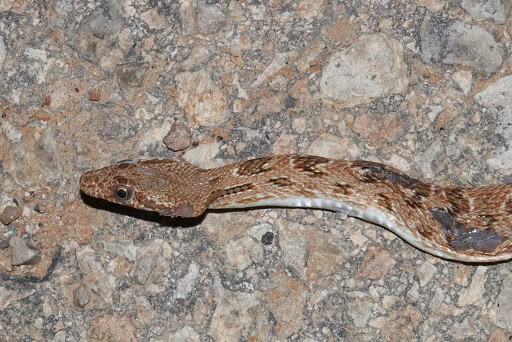
This non-venomous species is found in rocky, arid areas of the Middle East and North Africa. They feed primarily on lizards, and take shelter in cool burrows during the roasting daytime. Diadem snakes (Spalerosophis diadema) measure up to 150cm, and ordinarily have a slightly bulky head, which widens a little from the neck. When stressed, however, gears in their skull shift, which results in small bones jutting outwards to create a sharply triangular appearance.
Simultaneously, the diadem snake hisses loudly, and further mimics a viper by entering S-coil formation, with a sharp kink at the neck, a warning posture found in vipers worldwide from rattlesnakes to Bothrops lanceheads. Diadem snakes overlap with many vipers, but they bare the closest resemblance to Field’s horned viper (Pseudocerastes fieldi), a dangerously neurotoxic species.
A 2013 study mentioned a diadem snake found along an asphalt road outside outside Mamshit ruins in Israel, which triangulated its head, before immediately fleeing. Another was found on the ceiling of a concrete pipe undercrossing a main road. After dropping down, this snake hissed, triangulated its head, and coiled up aggressively. The second diadem snake was taken into captivity, and was so irritable initially that the scientists could barely photograph its head in the relaxed state. The snake was fed lizards for 3 months, and unlike humans, these never provoked a triangulation response.
